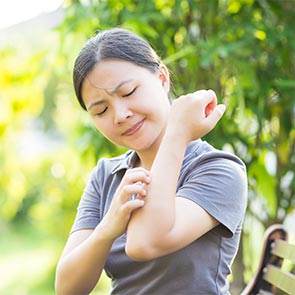Poison Sumac Rash Treatment in New Port Richey, FL

Have you recently traveled to a swampy area, and you're experiencing itching, burning, or blisters on your skin? Is an area of exposed skin swollen and red? You may have come into contact with poison sumac, a shrub that causes a painful skin reaction called dermatitis.
Poison sumac is native to swampy areas of southern, eastern, and some midwestern regions of the United States. While some people are more sensitive to poison sumac, all people will have some reaction to extended poison sumac exposure.
Prolonged exposure to the plant or inhaling poison sumac smoke can be extremely threatening to your health. If you're experiencing severe symptoms or think you've inhaled poison sumac smoke, don't wait - get emergency medical attention immediately.
While routine poison sumac rashes typically aren't dangerous, seeking attention for any medical problem is always a good idea. To speak with a poison sumac dermatitis specialist today in New Port Richey, call (813) 536-3212 or contact Dr. Christopher Van Benschoten online.
What are the symptoms of poison sumac exposure?
Poison sumac, poison oak , and poison ivy all contain an irritating sap called urushiol. When urushiol touches your skin, it stimulates an immune response, making the area swollen, red, and itchy. While brief exposure to urushiol doesn't usually cause a reaction, prolonged exposure causes an immune response resulting in dermatitis.
Poison sumac exposure happens more frequently during spring, summer, and early autumn when you're more likely to be outside. Though poison sumac dies down in wintertime, it's not dormant. If you touch the remaining branches or leaves in wintertime, you can get dermatitis from the sap remaining there.
The plant is found in many parts of the US, including:
- The deep southern US: Alabama, Mississippi, Louisiana, southern Georgia, North and South Carolina; found in eastern Texas, but not in most parts of Arkansas or Tennessee
- The Midwest: as far north as southeastern Minnesota; all over Wisconsin, Indiana, and Michigan; northern Illinois and northern Ohio; and eastern Kentucky; not found in West Virginia, Iowa, Missouri, Kansas, Nebraska, Oklahoma, or the Dakotas
- East Coast: from Florida to Maine, including North and South Carolina, Virginia, New Jersey, Pennsylvania, New York, Delaware, Rhode Island, Massachusetts, New Hampshire, Vermont, and Connecticut
Symptoms include:
- red skin rash appearing in streaks or patches
- itchiness and swelling
- blisters or bumps
Most everyone is susceptible to poison sumac dermatitis, though sensitivity varies from person to person. Poison sumac rash isn't contagious, though others can be affected if they come into contact with you or any object still containing traces of poison sumac oils.
In rare cases, a severe allergic reaction occurs. This usually happens when you're exposed to a large amount of poison sumac or the rash covers an extensive amount of your skin. Dermatitis is more dangerous when it affects your mucous membranes - the skin of your eyes, nose, mouth, and genitals.
If your exposure is extensive or your mucous membranes are affected, or if you have a severe allergic reaction, difficulty breathing, severe swelling, fluid leaking from blisters, or intense and intolerable itching, get medical attention right away.
Poison sumac smoke can also damage your throat, sinuses, and lungs. When poison sumac burns, its urushiol is transferred to the smoke and travels through the air, where it's easily inhaled. If the smoke touches your mouth, lips, sinuses, eyes, and lungs, it causes severe allergic reactions. Skin symptoms are typically mild and not a cause for medical concern, but inhaling poison sumac smoke can be fatal.
Call your medical provider or seek emergency medical care immediately if you've recently been exposed to wood smoke and experience the following symptoms:
- difficulty breathing
- rash inside your nose or mouth, or on your lips
- fever
How is poison sumac dermatitis diagnosed?
Simple poison sumac exposure typically doesn't require medical attention. However, if your rash is extensive or is causing extreme pain, itching, or other severe symptoms, you should absolutely seek medical care.
Diagnosis is usually straightforward because the dermatitis pattern of patches and streaks is easily recognized. Tell your medical provider you may have been exposed to a poisonous plant. Depending on the time of year and your geographical location, your rash may not be identified as the result of a certain plant.
If you haven't been to a swampy area recently, your medical provider may recommend allergy tests to discover the true cause of your dermatitis.
How is poison sumac rash treated?
Treatment focuses on reducing your allergic reaction until your body takes care of it. Getting lots of rest, taking cool showers (not very cold), and avoiding scratching if you can, will all give some relief. In most cases, mild to moderate dermatitis can be managed at home.
Always discuss all treatments with your medical provider before using them. Never apply antihistamine creams to your skin unless your medical provider advises it. He or she may also prescribe antibiotics for an infected rash.
Basic over-the-counter remedies include:
- calamine lotion
- topical anesthetics like menthol or benzocaine
- oral antihistamines like Benadryl: side effects include drowsiness
- ibuprofen or acetaminophen (never give aspirin or aspirin-based painkillers to people under the age of 18)
- cold compresses can reduce inflammation and relieve itching
Home remedies include:
- black tea: contains anti-inflammatory properties; do not apply when hot
- bathing in cool water with oatmeal, apple cider vinegar, or baking soda (never take a very hot or very cold bath, and don't rub your skin with a towel after)
- gel from aloe leaves: has anti-bacterial, anti-inflammatory properties (non-scented aloe gel or lotion can also be chilled to relieve pain and itching)
- witch hazel: can reduce rash and itching; use sparingly, in small dabs
- cucumber: mashed up into a paste, it can sooth the itch
- banana peel and watermelon rind: may relieve itching; cool in the fridge before applying
- apple cider vinegar: soaking a brown paper bag and placing it on the affected area may draw out the toxins and give relief
- lemon juice: may draw the oil out of your skin
Most poison oak rashes are annoying but not serious, lasting no more than 3-10 days. Your symptoms may continue up to 30 days if you're experiencing an intense reaction, but severe dermatitis is rare.
To avoid spreading urushiol and giving others dermatitis, wash your clothes immediately and shower to ensure you've removed all traces of the offending oil - avoid taking a bath, as it may spread the urushiol to other parts of your body.
Clean your shoes, socks, and outdoor gear right away, as it may be carrying traces of urushiol. Remember to wear gloves when handling these items, as touching the urushiol may cause you further dermatitis.
How can I avoid poison sumac exposure?
Common sense is the best way of avoiding poison sumac. If you're traveling to outdoor areas where poison sumac grows, educating yourself about the local plants and animals goes a long way. Familiarizing yourself with poison sumac's appearance is a good idea so you can identify the plant and stay away from it.
In the outdoors, wear long pants and long sleeves if possible. Stay on paths and trails and avoid touching undergrowth. If you have to leave the path, be careful about where you walk and what you touch. Poison sumac tends to grow quite large (up to 20 feet tall) and looks like a small tree with easily identifiable leaves, so knowing how to identify it is your first step toward avoiding poison sumac dermatitis.
If you touch poison sumac, you may be able to prevent or limit a skin reaction by applying rubbing alcohol or hand sanitizer to the area. This must be done very quickly before the oil penetrates your skin. Never put rubbing alcohol on inflamed skin or open blisters.
Reserve Your Appointment Now
Poison sumac exposure can cause an annoying skin rash. While most cases are mild, poison sumac can cause severe allergic reactions in some people and inhaling its smoke can be deadly. If you're experiencing a strong allergic reaction or think you've inhaled poison sumac smoke, don't wait - call your medical provider or seek emergency medical care right away.
To speak with a poison sumac specialist today in New Port Richey, call (813) 536-3212 or contact Dr. Christopher Van Benschoten online.
Evolution
Address
4691 Van Dyke RoadLutz, FL 33558
(813) 536-3212
www.evolution4health.com
Hours
Mon:
10:00 am - 4:00 pm
Tue:
10:00 am - 4:00 pm
Wed:
10:00 am - 5:00 pm
Thu:
10:00 am - 6:00 pm
Fri:
10:00 am - 3:00 pm
Sat:
Closed
Sun:
Closed


